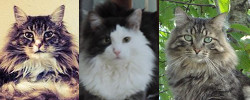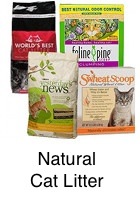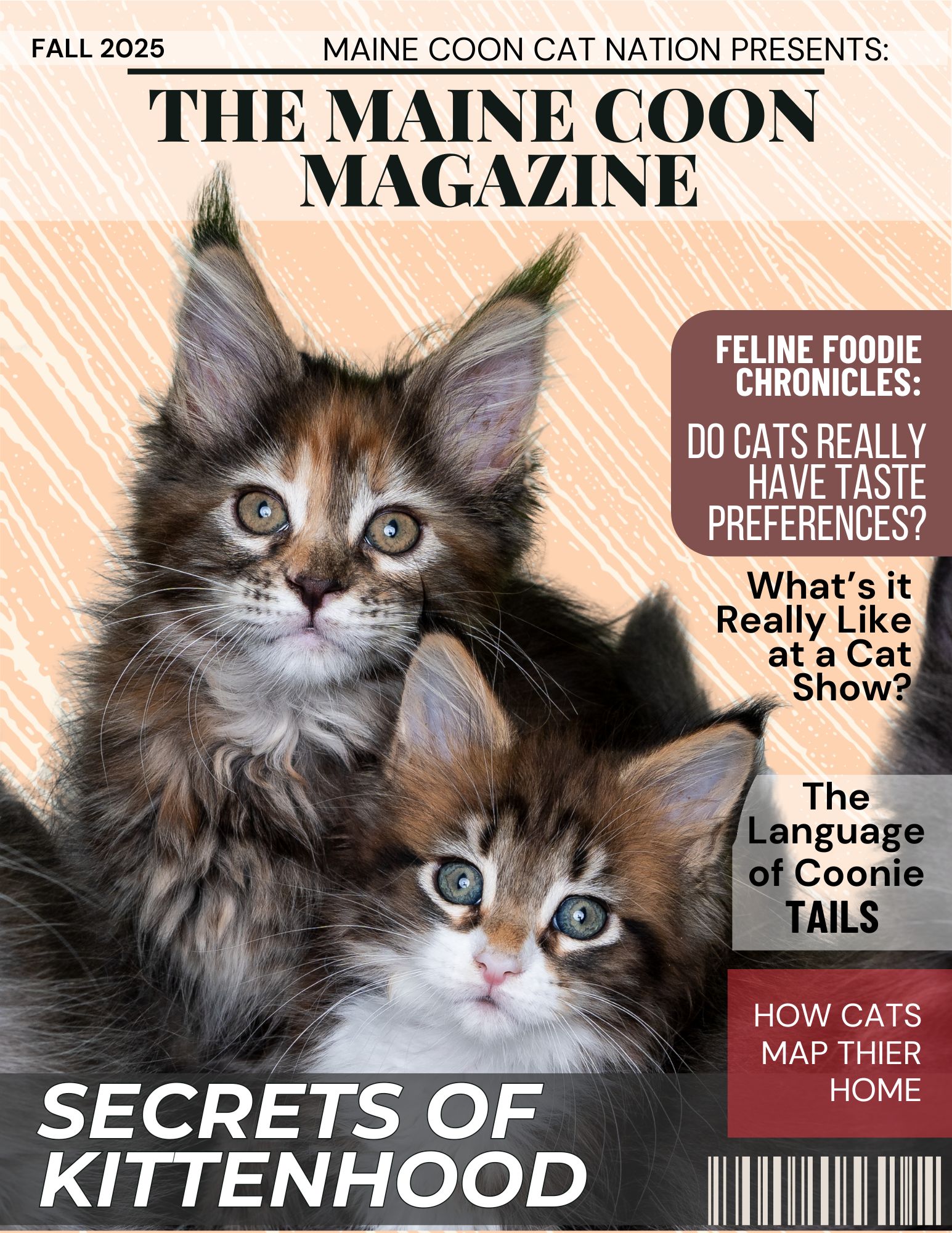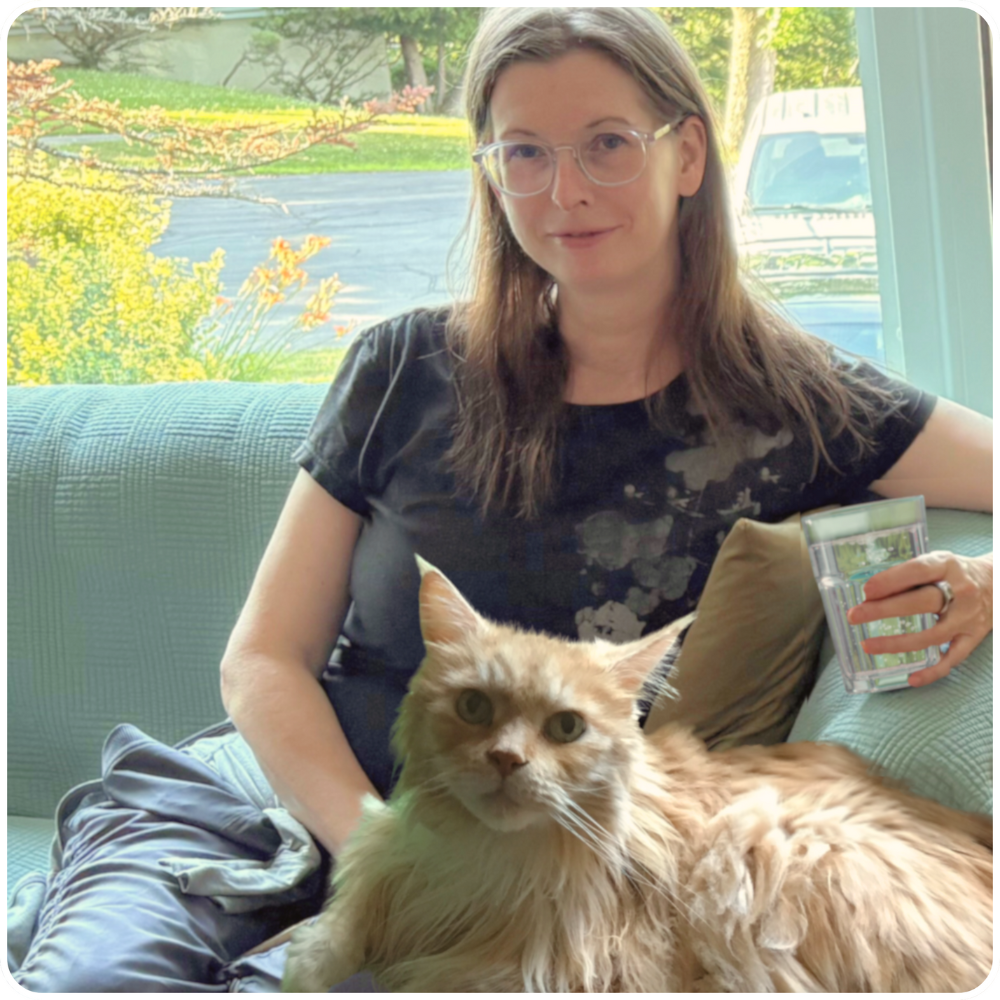- Home
- Litter Box Care
Maine Coon Litter Box Problems & Care
Welcome to our headquarters for Maine Coon litter box problems and best practices. Meeting their needs will help head off any issues before they arise.
Tending to the litter box is a huge part of cat care, for any breed.
If you like this, you'll love our fun, free Daily Digest!


Are you wondering what style to get, how many, where to place them, or what type of kitty litter to get?
There is actually much more to the whole subject than meets the eye, or nose! What about an automatic cat litter box? We'll go over those, too.

One of the most common reasons for a cat to be surrendered to a shelter is poor cat litter box behavior.
Almost all of these circumstances are a result of the cat not having their needs met in this area. Maine Coon cats tend to be meticulous and perfectly trained.
He might be blocked from his box by a dominant cat, he might want a different litter, size or shape of box, or maybe it's just too dirty for him.
It's always important to check medical reasons, too. Bladder infections, diabetes, even discomfort from fleas can cause a cat to eliminate elsewhere.
In fact, anytime a cat with normally good habits "goes" in the wrong place, alarm bells should go off. There's always a reason for it.
Constipation in cats can cause straining, discomfort, and even litter box avoidance.
Oliver’s story shows how daily meds and diet tweaks can make a big difference for chronic cases.
Choosing a Cat Litter:
One of the more popular brands of cat litter that I grew up with is called Fresh Step litter.
We used fresh Step Litter for many years, before learning about the benefits of dust free cat litter over clay cat litter. Clay cat litter is falling out of favor, and dust free cat litter is the way to go.
The most important aspect of this subject is that cats are naturally clean animals. It's their instinct to have a clean, nice smelling place to go to the bathroom.
Individual cats each have their own preferences as to style of box, type of litter, even privacy. So take all your cats likings seriously, and everyone will be happy!
Types of Cat Litter
Basically, kitty litter falls into two categories, clumping and non-clumping. There are advantages and disadvantages to both.
Most cats and their owners agree that the clumping litter wins, since it has the convenience of being scoop-able. That's the only way to really keep it clean.
There is some concern about the health of clay cat litter.
Many people are looking into natural litter and dust free cat litter as a healthier alternative.

For years, we used traditional clay litter. This section is all about our switch from clay cat litter to natural, dust free cat litter. We're very happy with the transition!
Read our experiences and final thoughts after trying out the different types of natural cat litter.
There are fans of each type of litter. Each has benefits such as great odor control or being all-natural, or flushable. And each has drawbacks, such as being dusty or messy.
You'll want at least a few inches of litter, so that it will scoop out easily. Three or more inches will keep your cat happy. He shouldn't have to scrape the bottom.
Whatever you choose, the most important thing is that your cat likes and uses it!
If you are interested in trying natural litter, but aren't sure what it's all about, we've added a comprehensive review of our experiences with Feline Pine, as well as an account of our time spent with World's Best Litter. Additionally, our readers have shared their reviews of World's Best.
Some of our top house cat care tips are about natural cat care. "Going natural" is as good for our pets as it is for us!
Cat Litter Box Styles and Choices
The Open Type
Many people have success using large, heavy rectangular pans. You can even get a great thick and heavy pan at a hardware store.
The kind used for cement mixing. These hold up really well, and they are bigger and sturdier than the ones you see at the pet store.
Another option is big storage bins. They have the advantage of really high sides, great for keeping litter from getting sprayed around.
They are also great for cats who sit the "wrong way" over the edge of the box. I had a cat years ago who did this. What a pain! You can cut into the side of it for access.
The Covered Type:
There are many different types of covered cat litter boxes. They can be round, rectangular, large or small. This covered style is what we started out with, and it worked quite well for us for a while.
Then, as most Maine Coon cats will, Leo soon outgrew it. I had to take the cover off. There was no way around it. And there is no way around the fact that Maine Coon cats are bigger, sometimes much bigger than your average house cat!
This is a very real factor, so if you have a young kitten, get ready to expand your litter box area!
It'll be clear when you see your cat enter, have difficulty turning around, maybe even lift the cover a little with his back.
Hooded cat litter boxes also contain the dust from the litter. Ever notice how much dust from clay cat litter fills the air when you pour in a new supply of kitty litter?
When they dig around, they are breathing it in. You may want to look into some dust free cat litter.
It can be hard to turn around, dig, and keep their feet clean. To think about that big tail dragging around in there, and then heading for the furniture! To sum it up, a big Maine Coon cat needs space!
Visit our shopping page to see our Top Picks for Cat Litter Boxes
Fortunately, you can now find a covered cat litter box in extra large and jumbo sizes.
Some cats are claustrophobic and just don't like squeezing in to a hooded box. And if there are two or more cats, there can be a problem with the doorway.
A dominant cat will stake it out, not letting the other cat out the door. Or he might block the submissive cat from entering.
Some people really love the covered boxes because they trap odors. That's handy, but it is so important to remember one thing. Even when people don't smell litter box odor, the cat does smell it.
Their sense of smell is many times more sensitive than our own. So when they get ready to enter their "bathroom", and it is full of trapped odors on the inside, what will they do?
Using a covered cat litter box means scooping very regularly. At least once a day, ideally every time they use it. And it should be used with a dust free cat litter.
The Automatic Cat Litter Box
An automatic cat litter box can be very handy, keeping the litter area clean for the cat to walk around in.
Just remember it doesn't mean it is totally self-sufficient. Smelly waste is still around, it still needs to be removed regularly. But these can definitely be a really useful alternative.
How Many?
At least one per cat. Some cats like to pee in one, and poop in another. And some cats don't like to share. If there is a dominance issue, put them in separate areas of the home.
If your home is big, you might want one per floor. And have one in any closed area where the cats spend their time, like a porch or garage.
The general rule of thumb is to have one litter box per cat plus one extra.
It's so important to always have the cat litter boxes accessible, because once a cat goes elsewhere, even as a last resort, it can be a downward trend. They will be just a little more ready to return to that spot in another "emergency".
Other Tidbits:
It's helpful to use a mat of some sort to keep the litter from spreading. And it's a good idea to wash out the litter boxes periodically.
Bleach works great to kill any bacteria, and it's perfectly safe, as long as its rinsed very well.
Cat litter box care is certainly the least glamorous part of cat care. But, it is so important. Clean boxes maintained the way your cat likes makes him happy. And if he's happily using his box, everyone's happy!
Maine Coon Litter Box Problems
A big Maine Coon cat can have special needs when it comes to bathroom time. And, as much as we adore our feline family members, on occasion we have to deal with Maine Coon litter box problems.
Here are our community pages. They are full of helpful advice from fellow Coonie parents:
Cat Litter, Boxes and Care: Reader Q & A's: These readers want to know what type of litter to purchase, and how best to care for the cat litter boxes. See if your question is here.
Cat Pee Outside Litter Box: Reader Q & A's: A frustrating cat behavior problem is cat pee outside the litter box. Here we share many tips & advice for cat peeing problems.
Cat Poop Outside Litter Box: Reader Q & A's: Why does a cat stubbornly poop outside the litter box? These cat owner questions and comments will help you stop this behavior.
Cat Poop Stuck in Fur: How to Keep Your Feline Friend Clean: Longhaired cats are prone to getting cat poop stuck in fur. If you have a problem with dingleberries, dags or feces stuck in fur try these reader suggestions!

